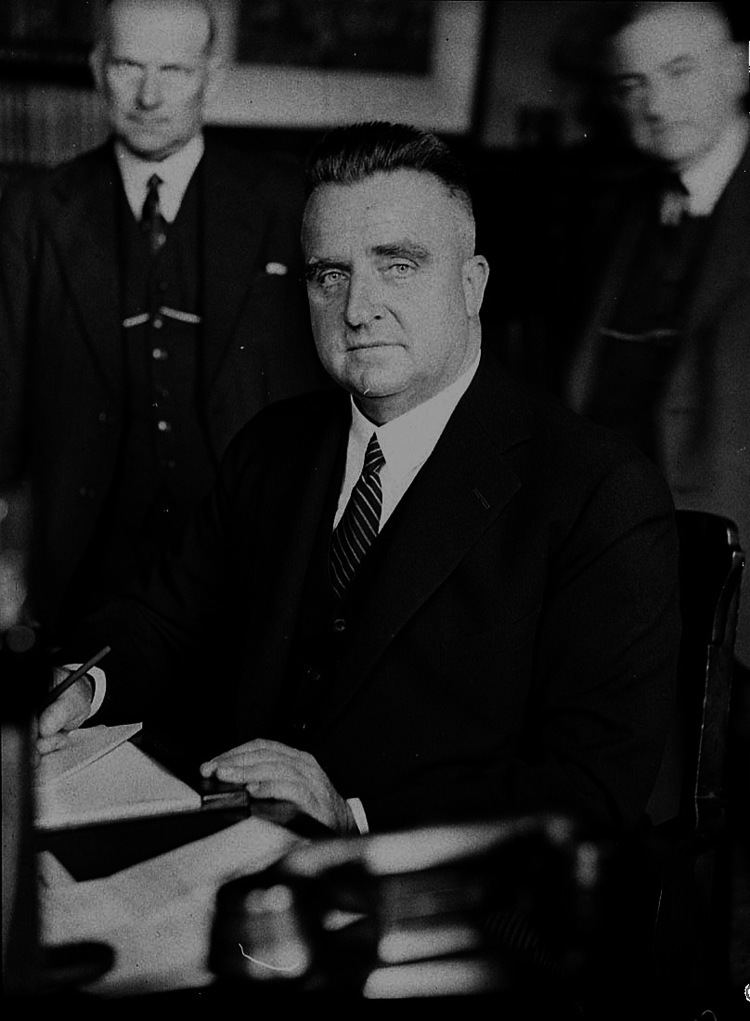Governor Lord Wakehurst Name Bertram Stevens | Spouse Edith Anderson (m. 1914) Role Politician | |
 | ||
Monarch George VEdward VIIIGeorge VI Born 2 January 1889Redfern, New South Wales, Australia ( 1889-01-02 ) Died March 23, 1973, Concord, Sydney, Australia | ||
Sir Bertram Sydney Barnsdale Stevens (2 January 1889 – 24 March 1973) was an Australian politician and the Premier of New South Wales from 16 May 1932 to 5 August 1939. At the time of his resignation, he was the longest continuous serving Premier of New South South Wales at 7 years and 2 months.
Contents
Early life
Stevens was born in the Sydney suburb of Redfern and attended Fort Street High School. An accountant by training, the teetotal Methodist Stevens worked for years in local government and various civil service departments. In 1914, he married Edith Lillie Anderson and they had one son and two daughters. In 1924, he became under-secretary and director of finance at the State Treasury, where he came into conflict with the ALP Premier and Treasurer, Jack Lang and subsequently resigned. In 1927, he became an alderman on Marrickville Council.
Political career
In 1927 Stevens entered the Legislative Assembly, as member for the Sydney suburban electoral district of Croydon. During the Nationalist Party Premiership of Sir Thomas Bavin, Stevens served first as Assistant Treasurer, and from 1929 as Treasurer. Not long after the Great Depression ended Bavin's administration in 1930, Stevens became Deputy Leader of the Opposition. In 1932 the Nationalist Party was absorbed into the United Australia Party, and Stevens became that party's state parliamentary leader. In May 1932 the Governor Sir Philip Game dismissed the Lang government, which was in dispute with Australia's federal government of James Scullin, and appointed Stevens as caretaker Premier. Stevens immediately called a new state election, which his party won in a landslide. His major reform was the replacement of the appointed Legislative Council, by a Council elected by the whole parliament to terms equivalent to four Assembly terms, that is up to 12 years; this was passed by referendum in 1933. He reduced the protections for mortgagors and tenants that had been introduced by Lang's 1925–27 government. The UAP was re-elected (by somewhat reduced majorities) in 1935 and 1938, each time against the Lang-led Labor Party. For most of Stevens's seven-year Premiership, one of the longest in New South Wales history — it continued until the eve of World War II — he was his own Treasurer.
Although Stevens's dealings with Country Party leader and Deputy Premier Sir Michael Bruxner were friendly, the same was not true of his working relationship with the United Australia Party's deputy leader, Eric Spooner. From 1936 onward, Spooner often censured Stevens for not running a balanced budget. Finally, in July 1939, Spooner resigned from cabinet. On 1 August, Spooner moved a parliamentary no confidence motion against Stevens's administration, succeeding by two votes. Stevens resigned, and Alexander Mair (Bruxner's favoured candidate) took over the Premiership.
Still only 50 years old, Stevens had hopes of a career in the federal parliament. Despite Sir Robert Menzies's attempts to discourage him, he abandoned his Assembly seat in 1940 and ran for the Labor-controlled constituency of Lang (named not after Stevens's opponent but after John Dunmore Lang, the 19th-century clergyman-politician) during that year's federal election. He was easily defeated by the ALP incumbent, Dan Mulcahy.
Later life
In 1941 and 1942, Stevens served as the Australian representative to the Eastern Group Supply Council in New Delhi. After the war, Stevens was president of the India League of Australia, and wrote prolifically upon Indian politics; but he never again held, or sought, elective office. He died in the Sydney suburb of Concord West, poor as a result of a long public service career and almost forgotten, survived by a son and two daughters. Stevens was accorded a state funeral and buried beside his wife who pre-deceased him in 1966 at Pine Grove Memorial Park, Minchinbury, New South Wales.
